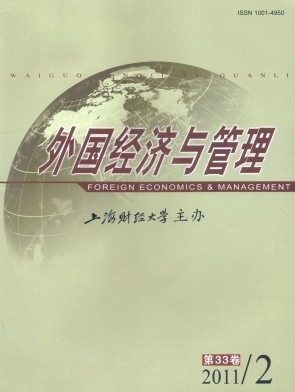企业信息系统采纳后行为研究评介与展望
外国经济与管理 2011 年 第 33 卷第 02 期, 页码:26 - 32
摘要
参考文献
摘要
随着信息化时代的到来,信息系统在企业中得到了广泛的应用,员工是企业信息系统的最终使用者,他们的采纳行为和采纳后行为受到了理论界和企业界的广泛关注。本文在回顾企业信息系统采纳后行为相关研究的基础上,分别对有关企业信息系统采纳阶段使用、采纳后持续使用以及采纳后深层次使用的研究进行了述评,并且对未来的研究方向进行了展望,以供我国企业信息系统采纳后行为管理研究和实践参考。
[1]Davis,F D.Perceived usefulness,perceived ease of use,and user acceptance of information technologies[J].MIS Quarterly,1989,13(3):319-340.
[2]Adams,D A,Nelson,R R,and Todd,P A.Perceived usefulness,ease of use,and usage of information technology:Areplica-tion[J].MIS Quarterly,1992,16(2):227-247.
[3]Sykes,T A,Venkatesh,V,and Gosain,S.Model of acceptance with peer support:Asocial network perspective to understandemployees’systemuse[J].MIS Quarterly,2009,33(2):371-393.
[4]McElroy,J C,Hendrickson,A R,Townsend,A M,and De Marie,S M.Dispositional factors in Internet use:Personality ver-sus cognitive style[J].MIS Quarterly,2007,31(4):809-820.
[5]Ki m,Hee-Woong,and Kankanhalli,A.Investigating user resistance toinformation systems i mplementation:Astatus quo biasperspective[J].MIS Quarterly,2009,33(3):567-582.
[6]Venkatesh,V,Brown,S A,Maruping,L M,and Bala,H.Predicting different conceptualizations of systemuse:The compe-ting roles of behavioral intention,facilitating conditions,and behavioral expectation[J].MIS Quarterly,2008,32(3):483-502.
[7]Bhattacherjee,A.Understanding information systems continuance:An expectation-confirmation model[J].MIS Quarterly,2001,25(3):351-370.
[8]Vatanasombut,B,Igbaria,M,Stylianou,A C,and Rodgers,W.Information systems continuance intention of Web-based ap-plications customers:The case of online banking[J].Information&Management,2008,45(7):419-428.
[9]Hsieh,J P-A,and Wang,W.Explaining employees’extended use of complexinformation systems[J].European Journal of In-formation Systems,2007,16(3):216-227.
[10]Jasperson,J S,Carter,P E,and Zmud,R W.Acomprehensive conceptualization of post-adoptive behaviors associated within-formation technology enabled work systems[J].MIS Quarterly,2005,29(3):525-557.
[11]Li mayem,M,Hirt,S G,and Cheung,C MK.Howhabit li mits the predictive power of intention:The case of information sys-tems continuance[J].MIS Quarterly,2007,31(4):705-737.
[12]Cheung,C M K,and Li mayem,M.Understandinginformation systems continuance:The case of Internet-basedlearning tech-nologies[J].Information&Management,2008,45(4):227-232.
[13]Wang,W,Hsieh,J P-A,Butler,J,and Hsu,S-H.Innovate with complexinformation technologies:Atheoretical model andempirical examination[J].Journal of Computer Information Systems,2008,49(1):27-36.
[14]Ahuja,M K,and Thatcher,J B.Moving beyondintentions and toward the theory of trying:Effects of work environment andgender on post-adoptioninformation technology use[J].MIS Quarterly,2005,29(3):427-459.
[15]Kevin,Z,and Kenneth,L K.Post-adoption variations in usage and value of E-business by organizations:Cross-country evi-dence fromthe retail industry[J].Information Systems Research,2005,16(1):61-84.
[16]Mao,E,and Palvia,P.Exploring the effects of direct experience on IT use:An organizational field study[J].Information&Management,2008,45(4):249-256.
[17]Saeed,K A,and Abdinnour-Hel m,S.Examining the effects of information systemcharacteristics and perceived usefulness onpost adoption usage of information systems[J].Information&Management,2008,45(6):376-386.
[18]Ki m,S S,and Son,J-Y.Out of dedication or constraint?Adual model of post-adoption phenomena andits empirical test inthecontext of online services[J].MIS Quarterly,2009,33(1):49-70.
[2]Adams,D A,Nelson,R R,and Todd,P A.Perceived usefulness,ease of use,and usage of information technology:Areplica-tion[J].MIS Quarterly,1992,16(2):227-247.
[3]Sykes,T A,Venkatesh,V,and Gosain,S.Model of acceptance with peer support:Asocial network perspective to understandemployees’systemuse[J].MIS Quarterly,2009,33(2):371-393.
[4]McElroy,J C,Hendrickson,A R,Townsend,A M,and De Marie,S M.Dispositional factors in Internet use:Personality ver-sus cognitive style[J].MIS Quarterly,2007,31(4):809-820.
[5]Ki m,Hee-Woong,and Kankanhalli,A.Investigating user resistance toinformation systems i mplementation:Astatus quo biasperspective[J].MIS Quarterly,2009,33(3):567-582.
[6]Venkatesh,V,Brown,S A,Maruping,L M,and Bala,H.Predicting different conceptualizations of systemuse:The compe-ting roles of behavioral intention,facilitating conditions,and behavioral expectation[J].MIS Quarterly,2008,32(3):483-502.
[7]Bhattacherjee,A.Understanding information systems continuance:An expectation-confirmation model[J].MIS Quarterly,2001,25(3):351-370.
[8]Vatanasombut,B,Igbaria,M,Stylianou,A C,and Rodgers,W.Information systems continuance intention of Web-based ap-plications customers:The case of online banking[J].Information&Management,2008,45(7):419-428.
[9]Hsieh,J P-A,and Wang,W.Explaining employees’extended use of complexinformation systems[J].European Journal of In-formation Systems,2007,16(3):216-227.
[10]Jasperson,J S,Carter,P E,and Zmud,R W.Acomprehensive conceptualization of post-adoptive behaviors associated within-formation technology enabled work systems[J].MIS Quarterly,2005,29(3):525-557.
[11]Li mayem,M,Hirt,S G,and Cheung,C MK.Howhabit li mits the predictive power of intention:The case of information sys-tems continuance[J].MIS Quarterly,2007,31(4):705-737.
[12]Cheung,C M K,and Li mayem,M.Understandinginformation systems continuance:The case of Internet-basedlearning tech-nologies[J].Information&Management,2008,45(4):227-232.
[13]Wang,W,Hsieh,J P-A,Butler,J,and Hsu,S-H.Innovate with complexinformation technologies:Atheoretical model andempirical examination[J].Journal of Computer Information Systems,2008,49(1):27-36.
[14]Ahuja,M K,and Thatcher,J B.Moving beyondintentions and toward the theory of trying:Effects of work environment andgender on post-adoptioninformation technology use[J].MIS Quarterly,2005,29(3):427-459.
[15]Kevin,Z,and Kenneth,L K.Post-adoption variations in usage and value of E-business by organizations:Cross-country evi-dence fromthe retail industry[J].Information Systems Research,2005,16(1):61-84.
[16]Mao,E,and Palvia,P.Exploring the effects of direct experience on IT use:An organizational field study[J].Information&Management,2008,45(4):249-256.
[17]Saeed,K A,and Abdinnour-Hel m,S.Examining the effects of information systemcharacteristics and perceived usefulness onpost adoption usage of information systems[J].Information&Management,2008,45(6):376-386.
[18]Ki m,S S,and Son,J-Y.Out of dedication or constraint?Adual model of post-adoption phenomena andits empirical test inthecontext of online services[J].MIS Quarterly,2009,33(1):49-70.
引用本文
王玮, 廖勇. 企业信息系统采纳后行为研究评介与展望[J]. 外国经济与管理, 2011, 33(2): 26–32.
导出参考文献,格式为:
下一篇:顾客组织社会化研究综述与未来展望





 6287
6287  675
675

